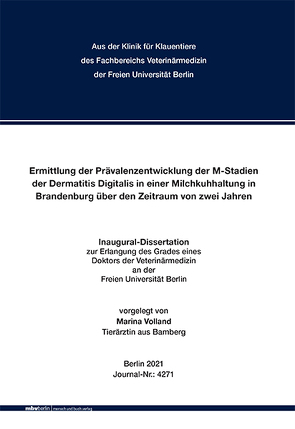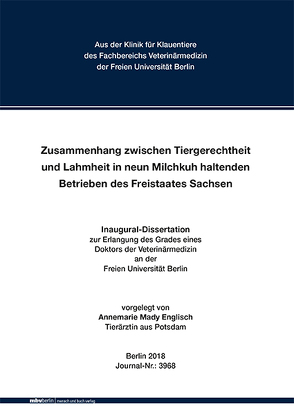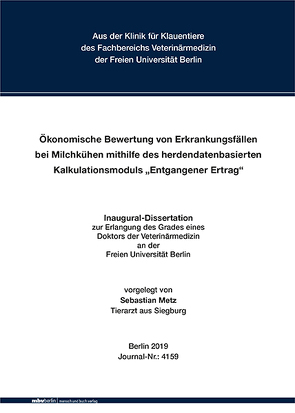
Die Dermatitis digitalis (DD) ist eine multifaktorielle Infektionskrankheit der Zwischenzehenhaut von Rindern, die mit Schmerzen und Leistungseinbußen bei den betroffenen Tieren einhergeht. Eine wichtige Grundlage für die Bekämpfung, die sich generell schwierig gestaltet, ist die Diagnostik der DD und ihrer klinischen Erscheinungsformen am Einzeltier und eine zeitnahe Behandlung. Um dies regelmäßig zu gewährleisten werden Methoden benötigt, die einfacher und stressfreier sind als die Inspektion der Gliedmaßen im Klauenstand (= Goldstandard). Eine gute Möglichkeit bietet beispielsweise die Bonitur von DD-Läsionen im Melkstand, da sie nicht mit den Betriebsabläufen interferiert.
Das Ziel der vorliegenden Arbeit war es, eine einfache Scoring-Methode für DD im Außenmelkerkarussell auf ihre Verlässlichkeit und Reproduzierbarkeit bezüglich des Erkennens verschiedener Erkrankungsstadien der DD zu untersuchen und zu evaluieren, ob diese Methode auch durch Betriebspersonal erlernt und durchgeführt werden kann. Des Weiteren sollten unter Anwendung dieser Methode die DD-Prävalenz und ihre zyklischen Schwankungen in einer brandenburgischen Milchviehherde über einen Zeitraum von 24 Monaten überwacht werden. Mögliche Einflüsse durch jahreszeitlich bedingte klimatische Schwankungen sollten hierbei ebenfalls berücksichtigt werden.
Alle Untersuchungen fanden zwischen Januar 2015 und Dezember 2016 in einem brandenburgischen Milchviehbetrieb statt. In diesem Zeitraum wurden täglich durchschnittlich 704 Kühe in einem Außenmelkerkarussell gemolken. Alle zu melkenden Kühe wurden dort einmal im Monat durch eine erfahrene BeobachterIn auf das Vorhandensein von DD-assoziierten Hautveränderungen an den distalen Hintergliedmaßen untersucht. Hierbei kamen, mit Ausnahme einer Taschenlampe zur besseren Inspektion des Zwischenklauenspaltes, keine weiteren Hilfsmittel zum Einsatz. Auf eine Vorreinigung der Klauen mit Wasser wurde ebenfalls verzichtet.
Die Evaluierung der Objektivierbarkeit und Treffsicherheit der Scoring-Methode fand an drei zusätzlichen und aufeinanderfolgen Beobachtungstagen statt. Hierfür bonitierten fünf BeobachterInnen mit unterschiedlichem Erfahrungsstand bezüglich der DD-Diagnostik die Unterfüße von 416 Kühen zu zwei aufeinanderfolgenden Melkzeiten im Außernmelkerkarussell. Nach dem zweiten Scoring wurde eine zufällige Stichprobe von 100 Tieren durch den Herdenmanager selektiert und einer detaillierteren Untersuchung durch dieselben BeobachterInnen in einem Klauenstand zugeführt. Die Einteilung der DD-Läsionen erfolgte hierbei nach dem sogenannten M-Schema von DÖPFER et al. (1997), modifiziert nach BERRY et al. (2012). Für die vorliegende Arbeit wurde dieses Schema auf Grundlage der Erkenntnisse von RELUN et al. (2011) und THOMSEN et al. (2008) noch deutlich vereinfacht, indem drei Merkmalskategorien gebildet wurden, die wie folgt definiert waren: M0 = gesunde Haut; Ma = aktive Läsion; Mc = chronische Läsion. Die Scoring-Ergebnisse aus dem Melkstand wurden jenen als Goldstandard geltenden Werten aus der Klauenstanduntersuchung gegenübergestellt. Auf diese Weise konnten Sensitivität, Spezifität, PPV, NPV, Intraobserver-Übereinstimmung, Interobserver-Übereinstimmung sowie die Übereinstimmung mit dem Goldstandard berechnet werden. Für die letzten drei Parameter erfolgte dies unter Ausschluss der zufälligen Übereinstimmung durch Ermittlung von κ-Koeffizienten, welche schließlich nach den Kategorien von LANDIS und KOCH (1977) interpretiert wurden.
Die beschriebene Methode stellt mit einer Untersuchungszeit von ca. zehn Sekunden pro Tier ein sehr einfaches und schnelles Verfahren zum Erkennen von DD-assoziierten Hautveränderungen dar. Die auf diese Weise ermittelte Prävalenz von DDgesamt (Ma+Mc) mit 70,6% fällt deutlich niedriger aus als jene im Klauenstand erhobene mit 86,6%. Die mittlere Sensitivität für das Erkennen von DDgesamt (Ma+Mc) lag bei 0,78, die Spezifität bei 0,69. Für Ma betrug die Sensitivität lediglich 0,32, für Mc 0,57, was folglich eine genaue Differenzierung der Merkmalskategorien mit dieser Methode nicht sicher zulässt.
Die κ-Koeffizienten für die Intraobserver-Übereinstimmung schwankten für die Beurteilung nach den drei modifizierten M-Stadien (M0, Ma, Mc) zwischen Werten von 0,149 und 0,535, was bestenfalls einer ausreichenden Übereinstimmung entspricht. Für das grundsätzliche Erkennen von DD-Läsionen (M0, Ma+Mc), lag der höchste κ-Wert bei 0,626, was einer mittelmäßigen Übereinstimmung gleichkommt. Erfahrene BeobachterInnen erzielten konstantere Werte und stimmten besser mit sich selbst überein als wenig erfahrene BeobachterInnen. Auch für die Interobserver-Übereinstimmung wurden Kappa-Werte in diesen beiden Kategorien berechnet. Die Bestwerte lagen hier bei 0,447 für die Bewertung der drei Merkmalskategorien (M0, Ma, Mc) und bei 0,571, wenn DD nur generell erkannt werden sollte (M0, Ma+Mc). Diese Werte entsprechen beide einer mittelmäßigen Übereinstimmung nach LANDIS und KOCH (1977). Zudem kann bei allen BeobachterInnen eine Steigerung der Übereinstimmungen am zweiten Untersuchungstag festgestellt werden, sodass von einem Lerneffekt ausgegangen werden kann.
Beim Vergleich der Scoring-Ergebnisse aus dem Melkstand mit jenen des Goldstandards konnten für die Kategorisierung nach drei Merkmalskategorien bestenfalls ausreichende und für die zwei Merkmalskategorien (M0, Ma+Mc) mittelmäßige Übereinstimmungen erzielt werden. Die meisten Missklassifikationen traten bei der Einstufung von Ma-Läsionen auf, die häufig fälschlicherweise den chronischen Veränderungen (Mc) zugeordnet wurden.
Im Verlauf von 24 Monaten schwankte die DD-Prävalenz unter Berücksichtigung aller Krankheitsausprägungen in der untersuchten Milchviehherde zwischen 54,6% und 90,4% und lag im Mittel bei 74,2%. Bei Betrachtung der einzelnen DD-Stadien ließ sich ein deutlicher Anstieg der chronischen Veränderungen (Mc) und ein Abfall der gesunden Unterfüße (M0) verzeichnen, wohingegen die Anzahl der aktiven Läsionen (Ma) zunächst auch etwas sank, dann aber weitestgehend stabil bei circa 20% blieb. Bei jahreszeitlicher Untergliederung des Untersuchungszeitraumes waren keine signifikanten Veränderungen der Prävalenz feststellbar (p = 0,102), die auf einen Einfluss der jahreszeitlichen Witterungsbedingungen zurückgeführt werden konnten.
Aus diesen Ergebnissen lässt sich schließen, dass die Methode ausreichend geeignet ist, um DD-assoziierte Hautveränderungen im Außenmelkerkarussell schnell zu erkennen, ohne dabei die Betriebsabläufe zu stören. Für eine genaue Differenzierung von M-Stadien sollte hingegen anderen, vergleichbaren Methoden unter Einsatz von Hilfsmitteln und mit Vorreinigung der Klauen der Vorzug gegeben werden. Auch eine vorherige Schulung der BeobachterInnen in der Diagnostik von DD ist unerlässlich, um valide Daten zu erzielen. Nach gründlicher Einführung kann die Methode auch durch Betriebspersonal angewandt werden, um die DD-Prävalenz zu überwachen, Ausbrüche zu erkennen und Therapieerfolge zu kontrollieren. Der Goldstandard ist nach wie vor die Untersuchung der Klauen in einem Klauenstand.
Aktualisiert: 2022-04-07
> findR *

Relation between animal suitability and lameness in nine dairy cow operations in Saxony, Germany
One of the major challenges regarding animal welfare and economics in modern dairy farming is the high lameness prevalence in dairy cow herds. This study aimed at identifying relations between animal suitability (housing and management conditions) and lameness in dairy cows. Based on the findings, evidence-based strategies to reduce the lameness prevalence were suggested. Furthermore, the identified risk indicators were used to develop a benchmarking system for lameness across farms. The proposed system shall serve as a feasible instrument to assess animal welfare and animal suitability within the framework of the farm’s internal control as required by the German Animal Welfare Act. 605 cows from 18 housing groups (fresh cows and high yielding) of nine conventional dairy farms across Saxony, Germany, were scored for locomotion according to the five-point-scale system of Sprecher et al. (1997) during the summer period of 2013. Cows with locomotion scores 3 and higher were classified as lame. The Animal Suitability Index (German Tiergerechtheitsindex) TGI 200/1994 by Sundrum et al. (1994) as well as other environmentally-based criteria and a questionnaire were used to assess animal suitability. Out of originally 119 variables, five variables were chosen by means of a four-stage selection procedure for the univariate and multivariate statistical modelling. The relation of these variables with lameness was tested in different three-level nested logistic regression models with cow as unit of analysis. The final model consisted of four variables: type of bedding in the cubicles, cleanliness of the lying surfaces, cubicle diagonal (distance from neck rail to rear curb), and type of floor in combination with the size of the traffic area per cow. Deep bedding in cubicles was non-significantly associated with lower lameness-odds compared to rubber mats. Lying surface cleanliness scores of 3 (moderate) and 4 (clean) were associated with a significantly lower lameness risk than a cleanliness score of 2 (intermediate). When the cubicle diagonal was between 195 and 200 cm, there was a lower tendency (non-significant) for lameness than for shorter or longer cubicle diagonals. Lameness was less frequent among cows that walked on floors that were partly or completely covered by rubber mats compared to cows that walked on hard floors (concrete or asphalt). This association was significant in combination with a traffic area between 2.12 and 3.21 m² per cow. In combination with a traffic area of 4.08 to 6.90 m², there was only a non-significant tendency for no lameness. Based on these results, exemplary strategies to improve animal suitability have been suggested which can help to reduce lameness prevalence.
This study combines scores of an index system, which is used for animal welfare assessment on organic farms in Germany, and other environmentally-based and management-based indicators for animal suitability in a risk analysis for lameness. The developed system can be used for the farm’s internal control as required by the German Animal Welfare Act. At the same time, it serves as a benchmarking tool for dairy farms and offers evidence-based approaches for the prevention of lameness. Further research is necessary to validate the suggested risk indicators in longitudinal studies. In addition, it should be tested in long-term interventional studies whether benchmarking and continuous follow-up can help to improve animal suitability and reduce the prevalence of lameness in dairy farms.
Aktualisiert: 2019-12-31
> findR *
MEHR ANZEIGEN
Bücher zum Thema foot diseases
Sie suchen ein Buch über foot diseases? Bei Buch findr finden Sie eine große Auswahl Bücher zum
Thema foot diseases. Entdecken Sie neue Bücher oder Klassiker für Sie selbst oder zum Verschenken. Buch findr
hat zahlreiche Bücher zum Thema foot diseases im Sortiment. Nehmen Sie sich Zeit zum Stöbern und finden Sie das
passende Buch für Ihr Lesevergnügen. Stöbern Sie durch unser Angebot und finden Sie aus unserer großen Auswahl das
Buch, das Ihnen zusagt. Bei Buch findr finden Sie Romane, Ratgeber, wissenschaftliche und populärwissenschaftliche
Bücher uvm. Bestellen Sie Ihr Buch zum Thema foot diseases einfach online und lassen Sie es sich bequem nach
Hause schicken. Wir wünschen Ihnen schöne und entspannte Lesemomente mit Ihrem Buch.
foot diseases - Große Auswahl Bücher bei Buch findr
Bei uns finden Sie Bücher beliebter Autoren, Neuerscheinungen, Bestseller genauso wie alte Schätze. Bücher zum
Thema foot diseases, die Ihre Fantasie anregen und Bücher, die Sie weiterbilden und Ihnen wissenschaftliche
Fakten vermitteln. Ganz nach Ihrem Geschmack ist das passende Buch für Sie dabei. Finden Sie eine große Auswahl
Bücher verschiedenster Genres, Verlage, Autoren bei Buchfindr:
Sie haben viele Möglichkeiten bei Buch findr die passenden Bücher für Ihr Lesevergnügen zu entdecken. Nutzen Sie
unsere Suchfunktionen, um zu stöbern und für Sie interessante Bücher in den unterschiedlichen Genres und Kategorien
zu finden. Unter foot diseases und weitere Themen und Kategorien finden Sie schnell und einfach eine Auflistung
thematisch passender Bücher. Probieren Sie es aus, legen Sie jetzt los! Ihrem Lesevergnügen steht nichts im Wege.
Nutzen Sie die Vorteile Ihre Bücher online zu kaufen und bekommen Sie die bestellten Bücher schnell und bequem
zugestellt. Nehmen Sie sich die Zeit, online die Bücher Ihrer Wahl anzulesen, Buchempfehlungen und Rezensionen zu
studieren, Informationen zu Autoren zu lesen. Viel Spaß beim Lesen wünscht Ihnen das Team von Buchfindr.


